Molecular Mechanisms Underlying Inhibitory Binding of Alkylimidazolium Ionic Liquids to Laccase
Abstract
1. Introduction
2. Results
2.1. Competitive Binding of Alkylimidazolium Cations
2.2. Hofmeister Series of IL Anions
2.3. Shift of Laccase Optimal pH by ILs
2.4. Scavenging of ABTS Cation Radicals by ILs
3. Discussion
3.1. Inhibitory Binding
3.2. Hofmeister Effects
3.3. Optimal pH Shift
3.4. Radicals Scavenging
4. Materials and Methods
4.1. Chemicals and Reagents
4.2. Laccase and Homologous Modeling
4.3. Molecular Docking Simulation
4.4. Reaction Tests
4.5. Inhibition Kinetics
4.6. UV/Vis Spectroscopy of the Laccase/IL Complex
4.7. Stability of ABTS Cation Radicals
5. Conclusions
Supplementary Materials
Acknowledgments
Author Contributions
Conflicts of Interest
Abbreviations
| [Emim]+ | 1-ethyl-3-methyl-imidazolium |
| [Bmim]+ | 1-butyl-3-methyl-imidazolium |
| [Hmim]+ | 1-hexyl-3-methyl-imidazolium |
| [Omim]+ | 1-octyl-3-methyl-imidazolium |
| [Dmim]+ | 1-decyl-3-methyl-imidazolium |
| EtSO4− | ethylsulfate |
| AOT− | sulfosuccinate |
| Ac− | acetate |
| [TMA]TfO | tetramethylammonium trifluoromethanesulfonate |
| SDBS | sodium dodecyl benzene sulfonate |
| ABTS | 2,2′-azino-bis-(3-ethylbenzothiazoline-6-sulphonic acid) |
| 2,6-DMP | 2,6-dimethoxyphenol |
References
- Mogharabi, M.; Faramarzi, M.A. Laccase and laccase—Mediated systems in the synthesis of organic compounds. Adv. Synth. Catal. 2014, 356, 897–927. [Google Scholar] [CrossRef]
- Kudanga, T.; Nemadziva, B.; Le Roes-Hill, M. Laccase catalysis for the synthesis of bioactive compounds. Appl. Microbiol. Biotechnol. 2017, 101, 13–33. [Google Scholar] [CrossRef] [PubMed]
- Klibanov, A.M. Improving enzymes by using them in organic solvents. Nature 2001, 409, 241–246. [Google Scholar] [CrossRef] [PubMed]
- Fiţigău, I.F.; Peter, F.; Boeriu, C.G. Oxidative polymerization of lignins by laccase in water-acetone mixture. Acta Biochim. Pol. 2013, 60, 817–822. [Google Scholar] [PubMed]
- Rodakiewicz-Nowak, J.; Jarosz-Wilkołazka, A. Catalytic activity of Cerrena unicolor laccase in aqueous solutions of water-miscible organic solvents—Experimental and numerical description. J. Mol. Catal. B Enzym. 2007, 44, 53–59. [Google Scholar] [CrossRef]
- Sivapragasam, M.; Moniruzzaman, M.; Goto, M. Recent advances in exploiting ionic liquids for biomolecules: Solubility, stability and applications. Biotechnol. J. 2016, 11, 1000–1013. [Google Scholar] [CrossRef] [PubMed]
- Gorke, J.; Srienc, F.; Kazlauskas, R. Toward advanced ionic liquids. Polar, enzyme-friendly solvents for biocatalysis. Biotechnol. Bioprocess Eng. 2010, 15, 40–53. [Google Scholar] [CrossRef]
- Zhang, J.; Zou, F.; Yu, X.; Huang, X.; Qu, Y. Ionic liquid improves the laccase-catalyzed synthesis of water-soluble conducting polyaniline. Colloid Polym. Sci. 2014, 292, 2549. [Google Scholar] [CrossRef]
- Rehmann, L.; Ivanova, E.; Gunaratne, H.N.; Seddon, K.R.; Stephens, G. Enhanced laccase stability through mediator partitioning into hydrophobic ionic liquids. Green Chem. 2014, 16, 1462–1469. [Google Scholar] [CrossRef]
- Rehmann, L.; Ivanova, E.; Ferguson, J.L.; Gunaratne, H.N.; Seddon, K.R.; Stephens, G.M. Measuring the effect of ionic liquids on laccase activity using a simple, parallel method. Green Chem. 2012, 14, 725–733. [Google Scholar] [CrossRef]
- Galai, S.; de los Ríos, A.; Hernández-Fernández, F.; Kacem, S.H.; Tomas-Alonso, F. Over-activity and stability of laccase using ionic liquids: Screening and application in dye decolorization. RSC Adv. 2015, 5, 16173–16189. [Google Scholar] [CrossRef]
- Liu, H.; Zhu, L.; Bocola, M.; Chen, N.; Spiess, A.C.; Schwaneberg, U. Directed laccase evolution for improved ionic liquid resistance. Green Chem. 2013, 15, 1348–1355. [Google Scholar] [CrossRef]
- Rodríguez, O.; Cristóvão, R.O.; Tavares, A.P.; Macedo, E.A. Study of the alkyl chain length on laccase stability and enzymatic kinetic with imidazolium ionic liquids. Appl. Biochem. Biotechnol. 2011, 164, 524–533. [Google Scholar] [CrossRef] [PubMed]
- Domínguez, A.; Rodríguez, O.; Tavares, A.P.M.; Macedo, E.A.; Longo, M.A.; Sanromán, M.Á. Studies of laccase from Trametes versicolor in aqueous solutions of several methylimidazolium ionic liquids. Bioresour. Technol. 2011, 102, 7494–7499. [Google Scholar] [CrossRef] [PubMed]
- Patel, R.; Kumari, M.; Khan, A.B. Recent advances in the applications of ionic liquids in protein stability and activity: A review. Appl. Biochem. Biotechnol. 2014, 172, 3701. [Google Scholar] [CrossRef] [PubMed]
- Zhao, H. Protein stabilization and enzyme activation in ionic liquids: Specific ion effects. J. Chem. Technol. Biotechnol. 2016, 91, 25–50. [Google Scholar] [CrossRef] [PubMed]
- Cornish-Bowden, A. The origins of enzyme kinetics. FEBS Lett. 2013, 587, 2725–2730. [Google Scholar] [CrossRef] [PubMed]
- Cambria, M.T.; Di, M.D.; Falconi, M.; Garavaglia, S.; Cambria, A. Docking simulation and competitive experiments validate the interaction between the 2,5-xylidine inhibitor and Rigidoporus lignosus laccase. J. Biomol. Struct. Dyn. 2010, 27, 501–509. [Google Scholar] [CrossRef] [PubMed]
- Chen, M.; Zeng, G.; Lai, C.; Li, J.; Xu, P.; Wu, H. Molecular basis of laccase bound to lignin: Insight from comparative studies on the interaction of Trametes versicolor laccase with various lignin model compounds. RSC Adv. 2015, 5, 52307–52313. [Google Scholar] [CrossRef]
- Hong, E.S.; Kwon, O.Y.; Ryu, K. Strong substrate-stabilizing effect of a water-miscible ionic liquid [BMIM][BF4] in the catalysis of horseradish peroxidase. Biotechnol. Lett. 2008, 30, 529–533. [Google Scholar] [CrossRef] [PubMed]
- Raseda, N.; Hong, S.; Kwon, O.Y.; Ryu, K. Kinetic Evidence for the interactive inhibition of laccase from Trametes verisicolor by pH and chloride. J. Microbiol. Biotechnol. 2014, 24, 1673–1678. [Google Scholar] [CrossRef] [PubMed]
- Jha, I.; Kumar, A.; Venkatesu, P. The overriding roles of concentration and hydrophobic effect on structure and stability of heme protein induced by imidazolium-based ionic liquids. J. Phys. Chem. B 2015, 119, 8357–8368. [Google Scholar] [CrossRef] [PubMed]
- Ters, T.; Kuncinger, T.; Srebotnik, E. Carboxylic acids used in common buffer systems inhibit the activity of fungal laccases. J. Mol. Catal. B Enzym. 2009, 61, 261–267. [Google Scholar] [CrossRef]
- Kumar, A.; Venkatesu, P. Does the stability of proteins in ionic liquids obey the Hofmeister series? Int. J. Biol. Macromol. 2014, 63, 244–253. [Google Scholar] [CrossRef] [PubMed]
- Inatomi, K.-I. Characterization and purification of the membrane-bound ATPase of the archaebacterium Methanosarcina barkeri. J. Bacteriol. 1986, 167, 837–841. [Google Scholar] [CrossRef] [PubMed]
- Hatch, A.L.; Jensen, R.G. Regulation of ribulose-1, 5-bisphosphate carboxylase from tobacco: Changes in pH response and affinity for CO2 and Mg2+ induced by chloroplast intermediates. Arch. Biochem. Biophys. 1980, 205, 587–594. [Google Scholar] [CrossRef]
- Yang, Z.; Yue, Y.-J.; Huang, W.-C.; Zhuang, X.-M.; Chen, Z.-T.; Xing, M. Importance of the ionic nature of ionic liquids in affecting enzyme performance. J. Biochem. 2008, 145, 355–364. [Google Scholar] [CrossRef] [PubMed]
- Lai, J.-Q.; Li, Z.; Lü, Y.-H.; Yang, Z. Specific ion effects of ionic liquids on enzyme activity and stability. Green Chem. 2011, 13, 1860–1868. [Google Scholar] [CrossRef]
- Tavares, A.P.; Pereira, J.A.; Xavier, A.M. Effect of ionic liquids activation on laccase from Trametes versicolor: Enzymatic stability and activity. Eng. Life Sci. 2012, 12, 648–655. [Google Scholar] [CrossRef]
- Liu, H.; Wu, X.; Sun, J.; Chen, S. Stimulation of laccase biocatalysis in ionic liquids: A review on recent progress. Curr. Protein Pept. Sci. 2016, 18. in press. [Google Scholar] [CrossRef]
- Chen, Y.; Li, S.; Xue, Z.; Hao, M.; Mu, T. Quantifying the hydrogen-bonding interaction between cation and anion of pure [EMIM][Ac] and evidencing the ion pairs existence in its extremely diluted water solution: Via 13C, 1H, 15N and 2D NMR. J. Mol. Struct. 2015, 1079, 120–129. [Google Scholar] [CrossRef]
- Ober, C.A.; Gupta, R.B. pH control of ionic liquids with carbon dioxide and water: 1-Ethyl-3-methylimidazolium acetate. Ind. Eng. Chem. Res. 2012, 51, 2524–2530. [Google Scholar] [CrossRef]
- Liu, H.; Zhou, P.; Wu, X.; Sun, J.; Chen, S. Radical scavenging by acetone: A new perspective to understand laccase/ABTS inactivation and to recover redox mediator. Molecules 2015, 20, 19907–19913. [Google Scholar] [CrossRef] [PubMed]
- Eshtaya, M.; Ejigu, A.; Stephens, G.; Walsh, D.A.; Chen, G.Z.; Croft, A.K. Developing energy efficient lignin biomass processing—Towards understanding mediator behaviour in ionic liquids. Faraday Discuss. 2016, 190, 127–145. [Google Scholar] [CrossRef] [PubMed]
Sample Availability: Samples of the laccase/[Bmim]Cl complex are available from the authors. |
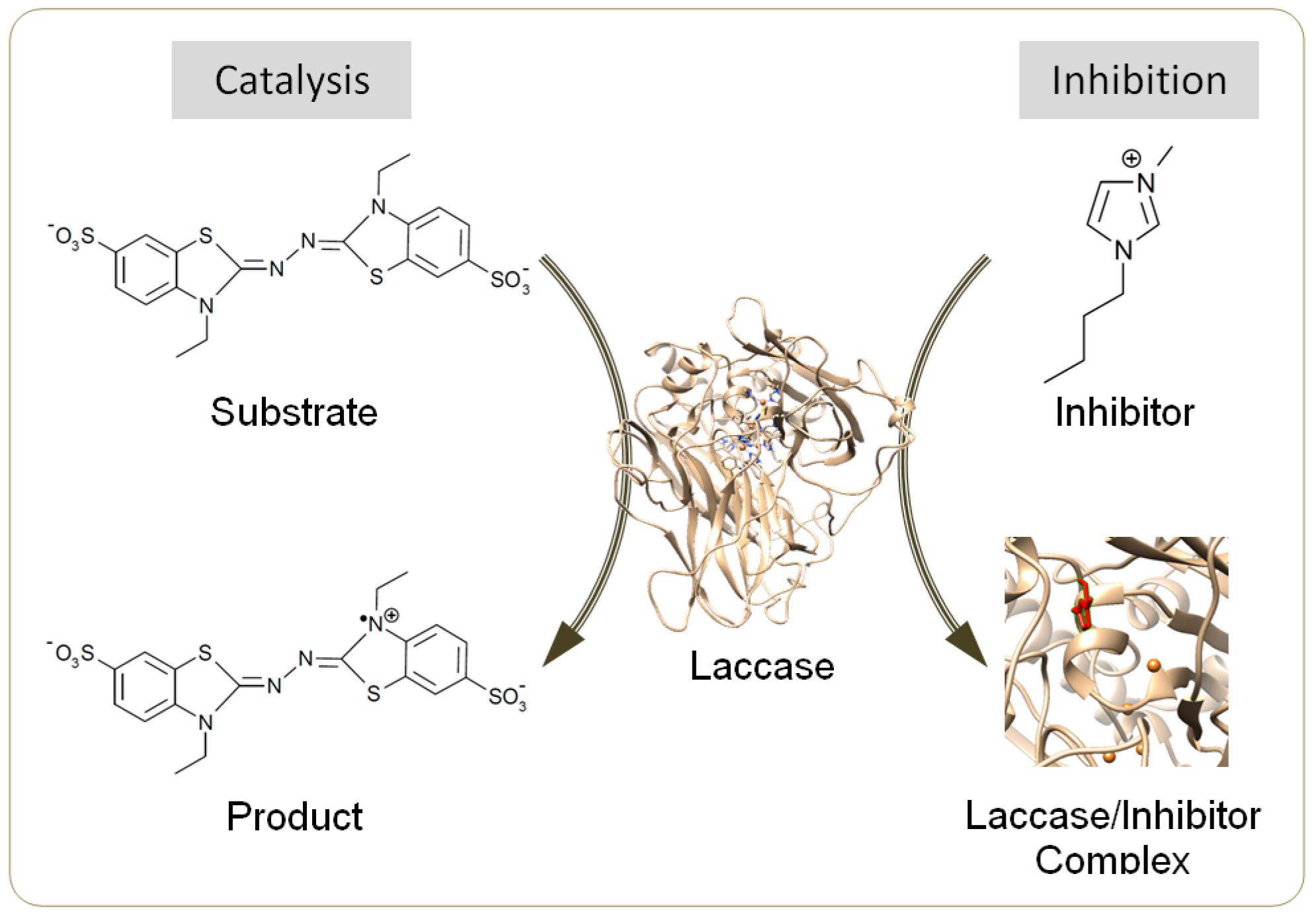
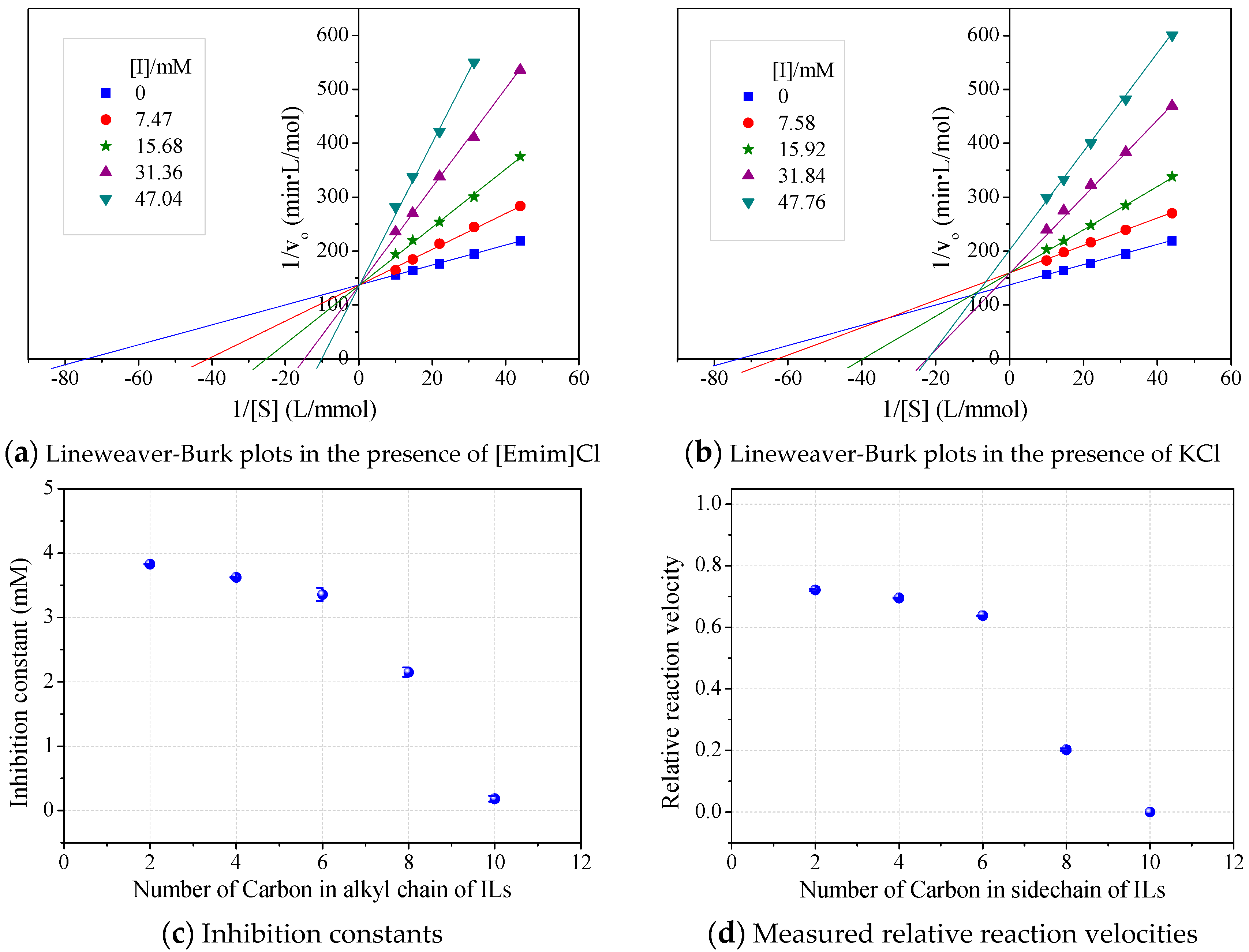
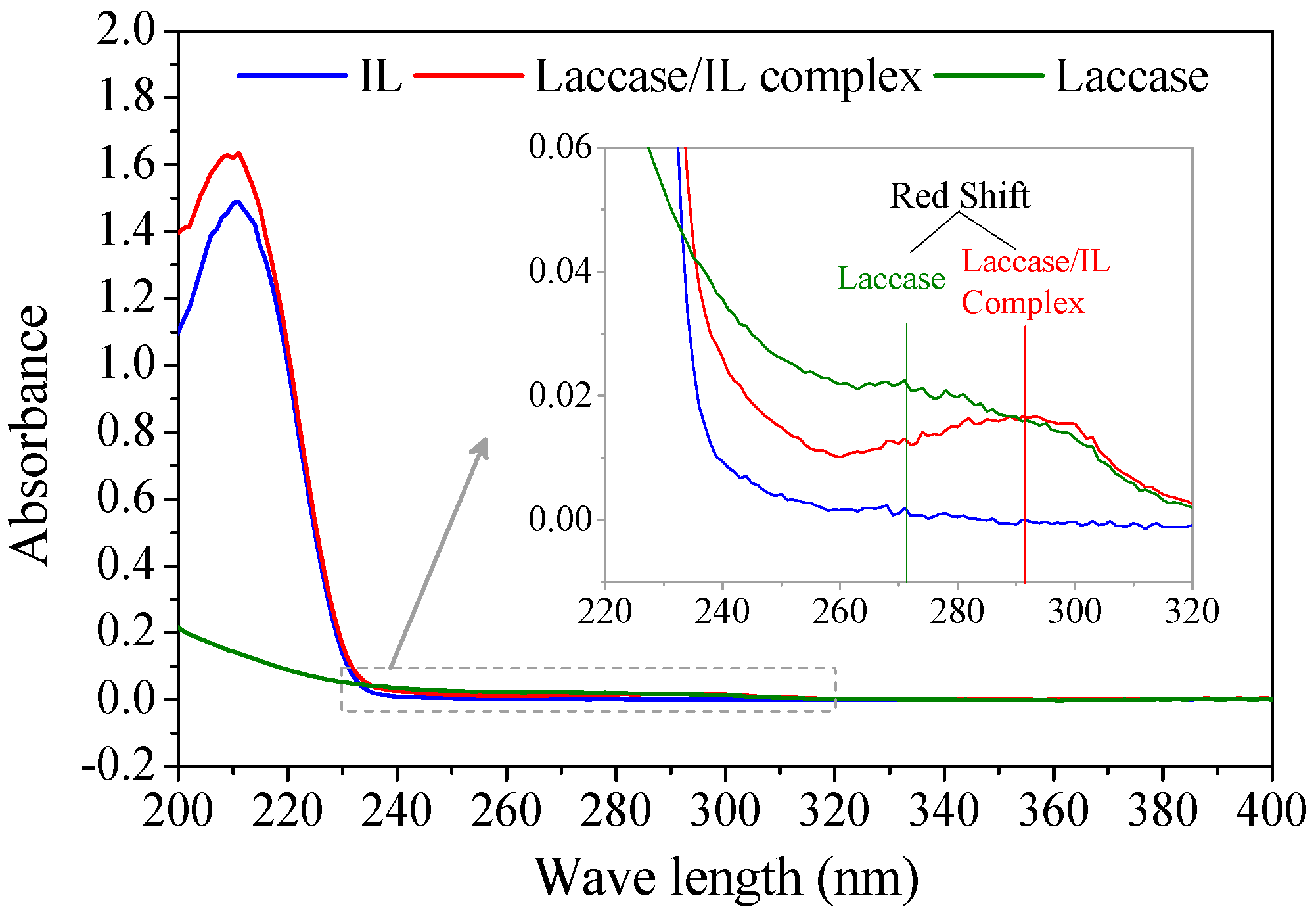
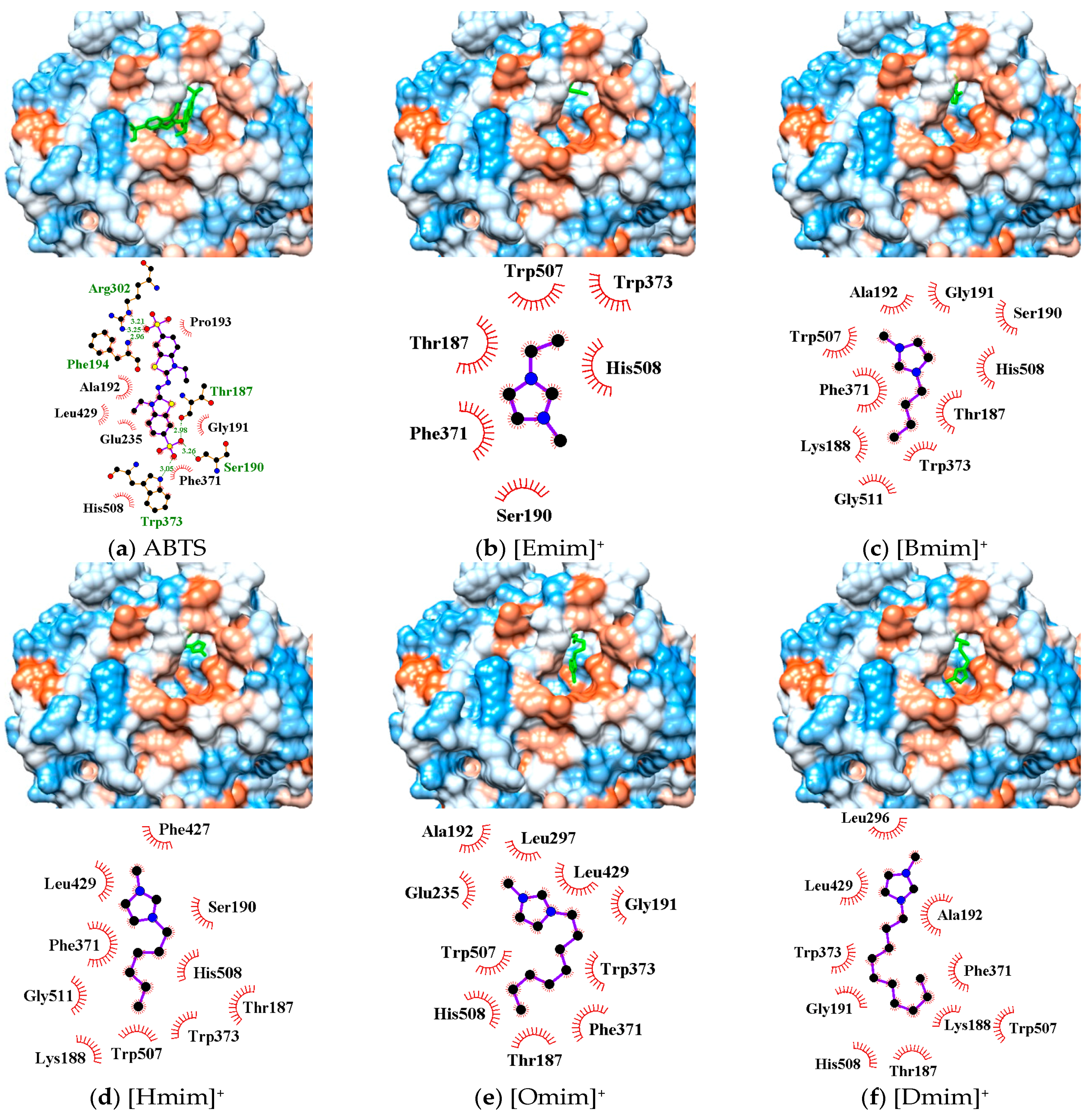
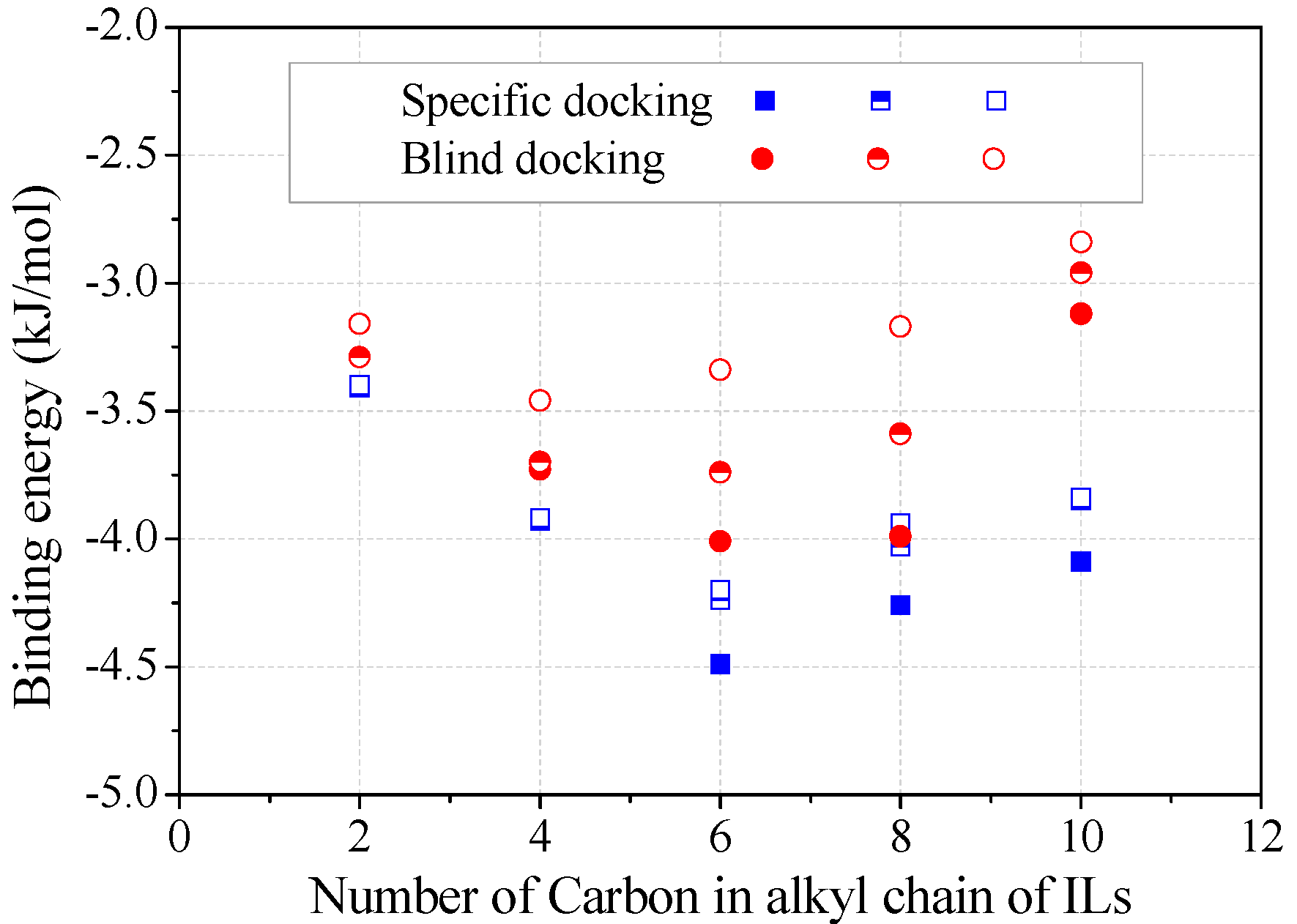
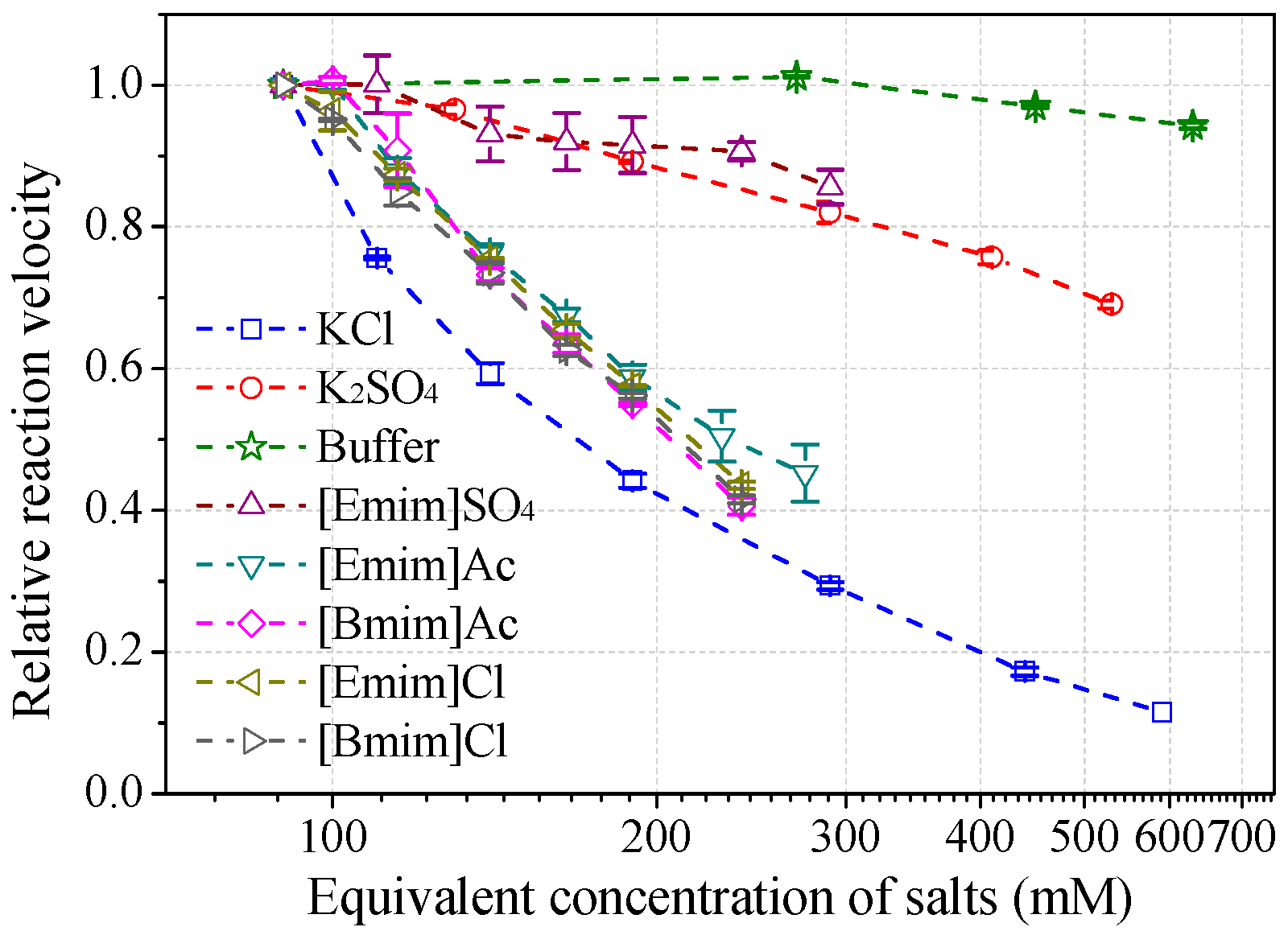

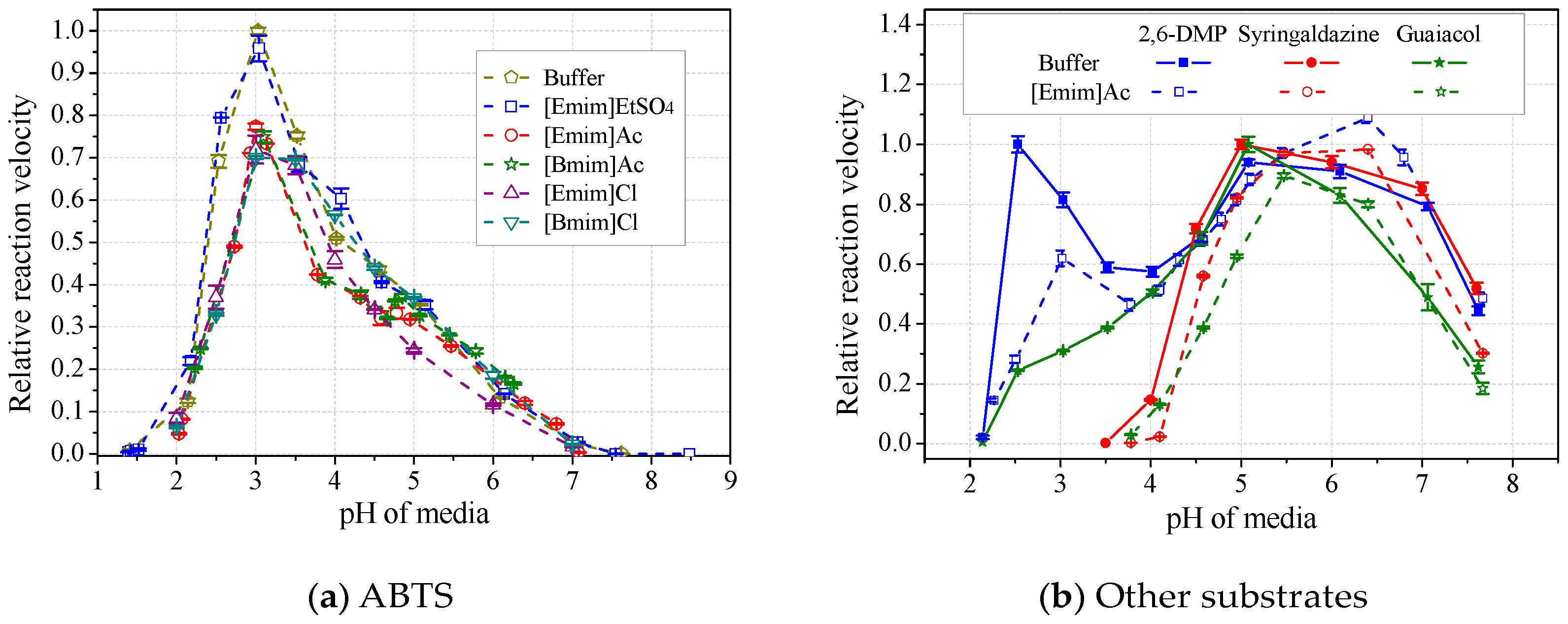
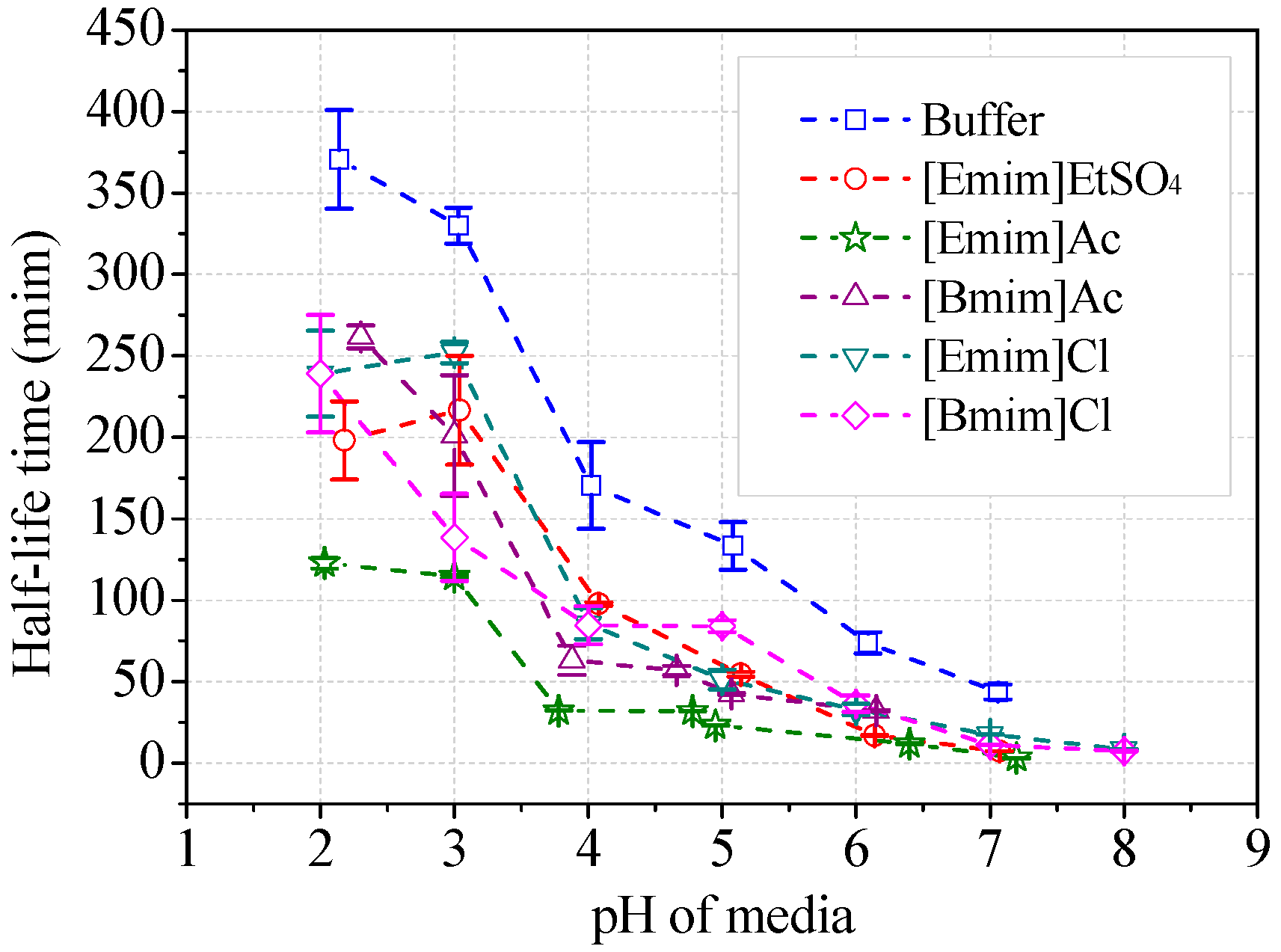
| Cations | |||||
 |  |  |  | 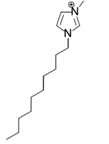 | |
| [Emim]+ | [Bmim]+ | [Hmim]+ | [Omim]+ | [Dmim]+ | |
| Anions | Substrates | ||||
 |  |  |  |  |  |
| Ac− | EtSO4− | 2,2’-azino-bis-(3-ethylbenzothiazoline-6-sulphonic acid) (ABTS) | 2,6-dimethoxyphenol (2,6-DMP) | Guaiacol | Syringaldezine |
| Substrate | Buffer | [Emim]EtSO4 | [Emim]Ac | [Bmim]Ac | [Emim]Cl | [Bmim]Cl |
|---|---|---|---|---|---|---|
| ABTS | pH 3 */ 100% | pH 3/ 95.9 ± 3.1% | pH 3/ 77.3 ± 0. 8% | pH 3/ 74.9 ± 1.3% | pH 3/ 72.1 ± 0.4% | pH 3/ 69.6 ± 0.2% |
| Syringaldazine | pH 5 *~6/ 100~94.1% | pH5~6/ 94.5~100.3% | pH5.5~6.5/ 96.9~98.3% | pH5.5~6.5/ 100.7~100.8% | pH 6/ 70.6 ± 2.7% | pH 6/ 79.7 ± 3.1% |
| 2,6-DMP(I) | pH 2.5 */ 100% | pH 2.5~3/ 84.3~84.8% | pH 3/ 61.9 ± 2.7% | pH 2.5~3.5/ 67.4~77.3% | pH 2.5~3/ 4.5~4.7% | pH 2.5~3/ 4.3~4.5% |
| 2,6-DMP(II) | pH 5 *~6/ 100~96.8% | pH 5~6/ 95.4~106.4% | pH 5.5~6.5/ 103.3~115.8% | pH 5.5~6.5/ 97.8~107.1% | pH 6/ 102.2 ± 0.3% | pH 6/ 102.9 ± 0.4% |
| Guaiacol | pH5 *~6/ 100~83.0% | pH5~6/ 99.4~93.7% | pH 5.5~6.5/ 89.55~80.01% | pH 5.5~6.5/ 96.4~82.4% | pH 6/ 38.9 ± 0.4% | pH 6/ 42.4 ± 0.9% |
© 2017 by the authors. Licensee MDPI, Basel, Switzerland. This article is an open access article distributed under the terms and conditions of the Creative Commons Attribution (CC BY) license (http://creativecommons.org/licenses/by/4.0/).
Share and Cite
Sun, J.; Liu, H.; Yang, W.; Chen, S.; Fu, S. Molecular Mechanisms Underlying Inhibitory Binding of Alkylimidazolium Ionic Liquids to Laccase. Molecules 2017, 22, 1353. https://doi.org/10.3390/molecules22081353
Sun J, Liu H, Yang W, Chen S, Fu S. Molecular Mechanisms Underlying Inhibitory Binding of Alkylimidazolium Ionic Liquids to Laccase. Molecules. 2017; 22(8):1353. https://doi.org/10.3390/molecules22081353
Chicago/Turabian StyleSun, Jianliang, Hao Liu, Wenping Yang, Shicheng Chen, and Shiyu Fu. 2017. "Molecular Mechanisms Underlying Inhibitory Binding of Alkylimidazolium Ionic Liquids to Laccase" Molecules 22, no. 8: 1353. https://doi.org/10.3390/molecules22081353
APA StyleSun, J., Liu, H., Yang, W., Chen, S., & Fu, S. (2017). Molecular Mechanisms Underlying Inhibitory Binding of Alkylimidazolium Ionic Liquids to Laccase. Molecules, 22(8), 1353. https://doi.org/10.3390/molecules22081353




